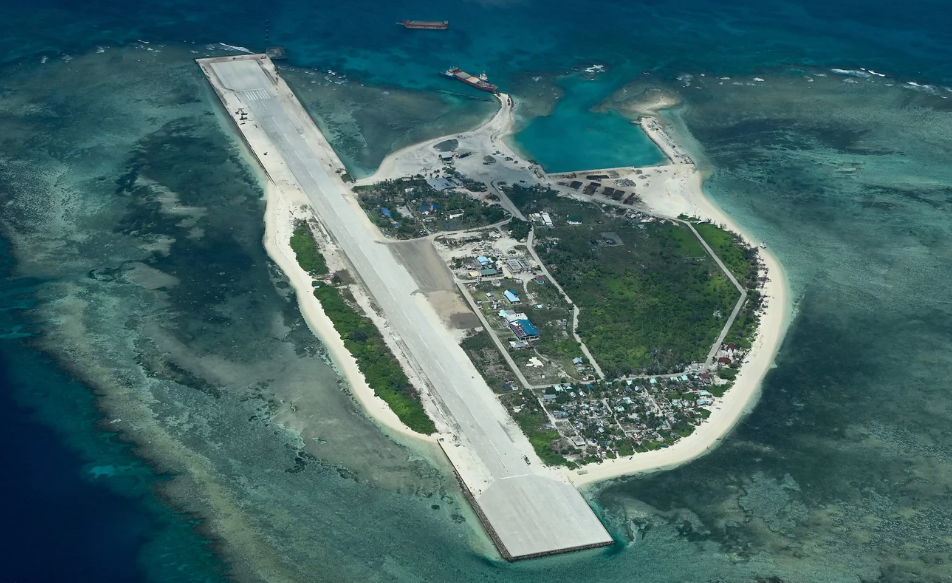By Phaidra Chrysostali,
The Spratly Islands, located in the South China Sea, are a hotspot of geopolitical tension due to overlapping territorial claims by China, the Philippines, Taiwan, Brunei, Malaysia and Vietnam. This cluster of more than 100 small islands, reefs and atolls spans a region rich in natural resources and strategic military importance. The conflict over these islands is driven by several factors, including the abundance of fisheries, potential oil and gas reserves, and their strategic location in one of the world’s busiest maritime trade routes.
Historically, the Spratly Islands have been used by fishermen and seafarers from various Southeast Asian countries. However, formal claims began in the early 20th century, intensifying post-World War II, as nations sought to expand their territorial waters. The United Nations Convention on the Law of the Sea (UNCLOS), established in 1982, allows countries to claim an Exclusive Economic Zone (EEZ) extending 200 nautical miles from their coastlines, further complicating matters as the Spratlys’ proximity to several countries leads to overlapping claims.
The strategic value of the Spratly Islands cannot be overstated. The region sits astride major shipping lanes that facilitate a significant portion of global maritime trade. Control over the islands equates to control over these crucial sea routes, enhancing a nation’s military and economic leverage. This is particularly vital for China, which sees the South China Sea as a critical component of its national security and economic strategy.
The Spratly Islands are believed to be surrounded by vast reserves of oil and natural gas, making them even more coveted. While exact figures are uncertain, estimates suggest that the area could hold billions of barrels of oil and trillions of cubic feet of natural gas. Additionally, the South China Sea is a rich fishing ground, crucial for the food security and economies of the surrounding nations.

In recent years, China has aggressively pursued its territorial claims by building artificial islands and establishing military bases in the Spratlys. These actions include constructing airstrips, harbors and radar facilities, effectively militarizing the region. Such developments have heightened tensions and led to confrontations with other claimant nations. For instance, the Philippines has repeatedly protested against Chinese incursions into its claimed areas, supported by international legal rulings such as the 2016 Permanent Court of Arbitration decision, which invalidated China’s extensive claims based on the “nine-dash line.”
Efforts to resolve the disputes diplomatically have seen limited success. ASEAN (Association of Southeast Asian Nations) has been involved in dialogues to promote peace and stability in the region, but consensus is often difficult due to the varying interests of member states. The United States and other Western nations advocate for freedom of navigation operations (FONOPs) to challenge excessive maritime claims and ensure open access to international waters. These operations sometimes involve naval patrols through disputed areas, which China views as provocations. Incidents, such as the collision between Philippine and Chinese vessels, underscore the volatility of the region. These encounters not only strain bilateral relations but also pose the risk of broader military conflict. Both sides have accused each other of aggressive maneuvers, and such incidents have sparked nationalistic sentiments, further complicating the path to peaceful resolution.
The future of the Spratly Islands dispute remains uncertain. While diplomatic negotiations continue, the militarization and strategic posturing by claimant nations suggest that the conflict will persist. Any significant resolution would likely require substantial compromises, backed by international legal frameworks and strong diplomatic engagements. The involvement of major powers like the United States and the rising influence of China add layers of complexity to an already intricate geopolitical puzzle.
In conclusion, the Spratly Islands exemplify the intricate interplay of national interests, regional stability and international law. The resolution of this conflict is crucial not only for the peace and prosperity of Southeast Asia but also for maintaining global maritime order and security.
Reference
- Νησιά Σπράτλι, ακόμη μια κουκίδα στο πουθενά: Αιτία «σφαγής», εδώ και δεκαετίες, για Κίνα, Φιλιππίνες, Ταϊβάν, Μπρουνέι, Μαλαισία και Βιετνάμ. Hellas Journal. Available here




